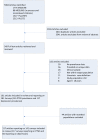Predicting the impact of the 2011 conflict in Libya on population mental health: PTSD and depression prevalence and mental health service requirements
- PMID: 22808201
- PMCID: PMC3396632
- DOI: 10.1371/journal.pone.0040593
Predicting the impact of the 2011 conflict in Libya on population mental health: PTSD and depression prevalence and mental health service requirements
Abstract
Background: Mental disorders are likely to be elevated in the Libyan population during the post-conflict period. We estimated cases of severe PTSD and depression and related health service requirements using modelling from existing epidemiological data and current recommended mental health service targets in low and middle income countries (LMIC's).
Methods: Post-conflict prevalence estimates were derived from models based on a previously conducted systematic review and meta-regression analysis of mental health among populations living in conflict. Political terror ratings and intensity of exposure to traumatic events were used in predictive models. Prevalence of severe cases was applied to chosen populations along with uncertainty ranges. Six populations deemed to be affected by the conflict were chosen for modelling: Misrata (population of 444,812), Benghazi (pop. 674,094), Zintan (pop. 40,000), displaced people within Tripoli/Zlitan (pop. 49,000), displaced people within Misrata (pop. 25,000) and Ras Jdir camps (pop. 3,700). Proposed targets for service coverage, resource utilisation and full-time equivalent staffing for management of severe cases of major depression and post-traumatic stress disorder (PTSD) are based on a published model for LMIC's.
Findings: Severe PTSD prevalence in populations exposed to a high level of political terror and traumatic events was estimated at 12.4% (95%CI 8.5-16.7) and was 19.8% (95%CI 14.0-26.3) for severe depression. Across all six populations (total population 1,236,600), the conflict could be associated with 123,200 (71,600-182,400) cases of severe PTSD and 228,100 (134,000-344,200) cases of severe depression; 50% of PTSD cases were estimated to co-occur with severe depression. Based upon service coverage targets, approximately 154 full-time equivalent staff would be required to respond to these cases sufficiently which is substantially below the current level of resource estimates for these regions.
Discussion: This is the first attempt to predict the mental health burden and consequent service response needs of such a conflict, and is crucially timed for Libya.
Conflict of interest statement
References
-
- United Nations. United Nations Security Council Resolution 1973. 2011. Available: http://www.un.org/News/Press/docs/2011/sc10200.doc.htm. Accessed 2012 15 Mar 15.
-
- Zeiton M. Frontline medicine: inside Libya. The Lancet. 2011;378:756–757. - PubMed
-
- Arie S. Agencies prepare to deal with mental health problems in Libya after 42 years of repression. BMJ. 2011;343:d5653. - PubMed
-
- World Health Organization. Libya crisis: August 2011 update. 2011. Available: http://reliefweb.int/sites/reliefweb.int/files/resources/Full_Report_212.... Accessed 2012 Feb 11.
Publication types
MeSH terms
LinkOut - more resources
Full Text Sources
Medical


